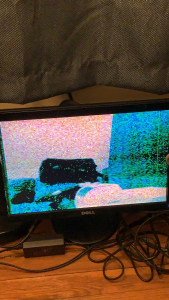Last week, our team spent the majority of the time working on the design report.
This week, our team spent time working on two major parts: getting data from the camera and outputting it into the VGA display, and the construction of the pyramid. We were able to get outputs from the camera and show it on the monitor. However, we ran into an unexpected, significant risk: the color scheme of the output. More details about this can be found in Breyden’s and Jullia’s status report here and here. This risk jeopardizes significant aspects of our project, including the final product as well as the interim construction of the live studio and chroma-keying implementation. We are managed this risk by highly prioritizing the color scheme until it is fixed, and we also have the backup plan that we planned to use in the case of non-functional chroma-keying: using a black backdrop and not including a chroma-keying implementation. This would enable a working, final project even in monochrome.
Even with the color scheme issue, we were still able to accomplish a lot of the tasks we set out to accomplish for this week: Getting I2c communication protocol to work on the Arduino to set up camera settings, decoding the pixel data coming from the camera, storing it into a frame buffer in BRAM, reading this data out from the frame buffer, and finally outputting it into the VGA display. Since these parts are working, it also shows that our PLLs are working and our design are holding up even with multiple clock domains. This shows the overall pipeline needed for our MVP and so once the color scheme settings issue is fixed, we will have a fully functioning pipeline for the display.
The second task of constructing the pyramid was worked on by Grace. She successfully tested the new plexiglass type which was easier to work with, met our project requirements, and held its shape well when the panels are put together.
Some changes to our design have also increased usage of our budget. Namely, we needed to switch plexiglass types due to the earlier kind not working, which caused us to purchase 24″x36″x0.03″ PET sheets for $34.99 and other different kinds of acrylic sheets for approximately $50 in total. We also need to purchase different kinds of backdrops for the live studio, in the case of non-functional color, which represents an additional cost. We will mitigate these costs by buying cheaper and fewer items until we are absolutely certain of our final design, though our budget is currently sufficient to manage all of these costs.
The previously mentioned tasks represents our critical path, or the tasks most important for us to achieve our MVP, and we are on track on building our MVP for the interim demo. Below is the updated schedule for this week, showing the tasks we have accomplished and currently working on.







